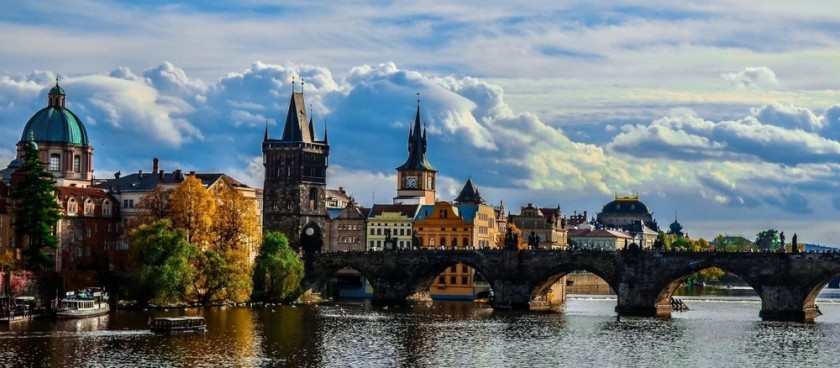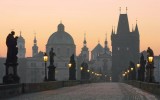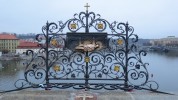- #CZ4
- Karlův most, 110 00 Praha 1, Czechia
- 50.0864840, 14.4114151 Copy to clipboard Copy
The Karluv Bridge became famous not only for the almost 700-year history and legends of this place but also for the mystical ability to make dreams come true.
Another feature is the sculptures of the Karluv Bridge, which breath with ancient history and special meaning.
Now the bridge connects the two parts of Prague and is undoubtedly its main symbol.
History and legends of Karluv Bridge
For the first time, a bridge was built across the Vltava River in the 12th century. It was a small stone bridge, which was later named after the wife of King Vladislav II. The bridge did not stand for long because the architect did not think over the preparedness of the bridge for the strong pressure of water. The only thing that remains of the first bridge is the tower, which tourists can contemplate even now. But the absence of a bridge made it very difficult to cross to the other side, so King Karluv IV gave an order to build a new, but stronger and better-quality bridge on the site of the old one. To build the Karluv Bridge, the king turned to a warlock and astrologer for advice, who named an auspicious date for laying the first stone. The first stone was laid at 5:31 am on July 9, 1357. It was this sequence of numbers that were considered harmonious and was favourable for the construction of such an important architectural structure as the Karluv Bridge. It is difficult to believe in the accuracy of the forecasts of the court astrologer, but the Karluv Bridge has managed to stand for almost 700 years. Locals believe in this legend and in the fact that the bridge will be able to withstand any flood and other external influences.
There is another legend associated with the name of one of the builders. For a long time, the young builder could not install the arch, and when he stood alone, the Devil appeared in front of him and offered an agreement. The only condition for the quick and successful installation of the arch was that the Devil would take the soul of the first one to step on the repaired bridge. The builder agreed because he wanted to finish the construction faster. He decided to outwit the Devil and let the rooster first, not the man. It was not stipulated which of the living beings this concerns. But he did not succeed in outwitting. The devil lured the builder's pregnant wife to the bridge. The next day, the young woman died along with her child. Many years later, on the bridge, they heard the sneezing of a lost soul, until one of the passers-by shouted: "Be healthy!" Legend has it that after this sneeze, passers-by did not hear, and the lost soul calmed down forever.
But these are just legends that pass from generation to generation. Now the Czech Republic is associated with the Karluv Bridge, which has also stood firmly and steadily for centuries.
Historical Gazette says that the main architect of the bridge was the well-known architect Parler, who developed the project for St. Vitus Cathedral. For 50 years, the city's best builders have been working on the construction of the bridge. And only at the beginning of the 15th century, Karluv Bridge was officially opened. The result not only met expectations but also exceeded. Karluv Bridge stands on 16 arches, and its width is 10 meters. Such a design will withstand many natural phenomena and even human impact.
Karluv Bridge has become a symbol of the city, so all the main events took place here. Knights, kings and queens roamed here, fairs and even courts were held. There are known cases when criminals and merchants were executed on the bridge who did not fulfil their slaves honestly. The main punishment is to put the criminal in a cage and let him down the river. But the military-strategic importance of the bridge cannot be overlooked. Here the Swedes were stopped after a long bloody war, and the Prussians were also defeated.
Nowadays, artists, street musicians and creative youth live on the Karluv Bridge. Although the crowds of tourists are the first thing that catches your eye. It was crowded here, both centuries ago and now. Karluv Bridge is the main bridge that connects the old part of the city to the new one.
How to make a wish?
Thousands of tourists who come to Prague must go to the Karluv Bridge to enjoy the picturesque nature, the harmony of the old and new parts of Prague, as well as make a wish. It is always full of tourists, both early in the morning and late in the evening.
There are only two places on the Karluv Bridge where tourists make wishes, and it will not be difficult to find them. A crowd of tourists will tell you the right places, because everyone, regardless of age, hopes for the fulfilment of desires.
Statue of Jan Nepomuk
For the desire to come true exactly, you need to observe the following sequence of actions: touch the right, and then the left (put your hand on the dog). And the desire to speak several times is obligatory.
How to make a wish on the Karluv Bridge
This place is considered to be a sign of where Jan was dropped into the Vltava. To make a wish come true, you need to touch the stars with your fingers and think about it.
But the main condition is that you need not make a material desire and only for good, then everything will come true. As the experience of experienced tourists who come back and make a wish again shows, anything is possible. Karluv Bridge in the Czech Republic is an amazing place that makes thousands of people happy.
How to get there?
There are many options for getting to the Karluv Bridge:
by metro to the Staromestska or Malostranska station;
by tram to the Karlovy lazne or Staromestska stop in Stare Mesto,
also to the Malostranske namesti stop in Mala Strana;
by bus to the Staroměstská stop;
on foot, as the pedestrian bridge is located near the centre of Prague.




